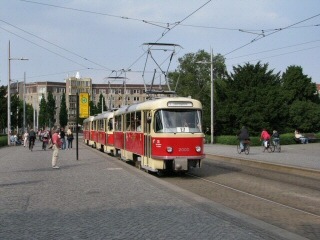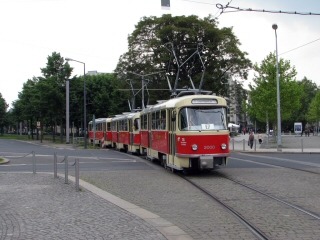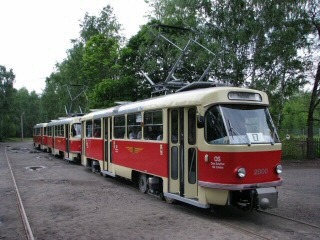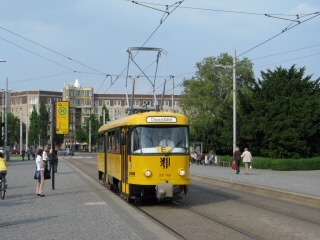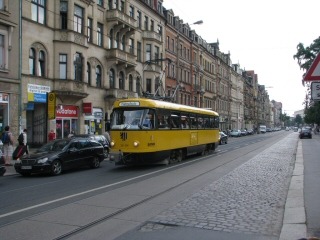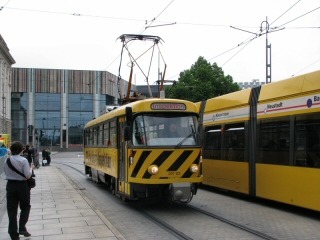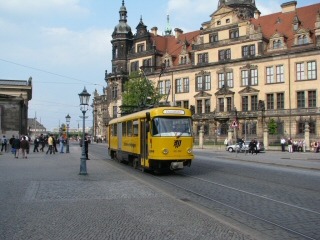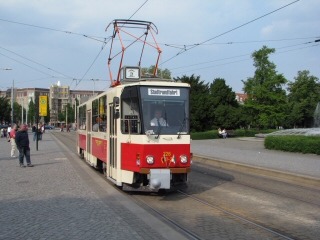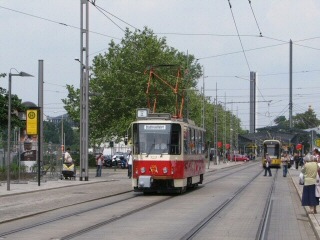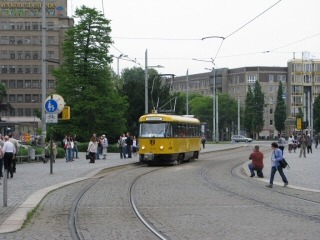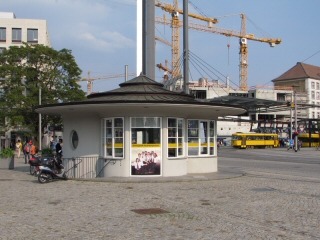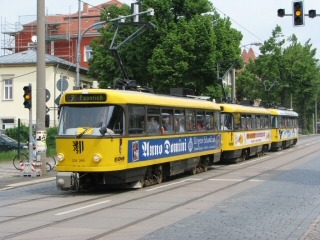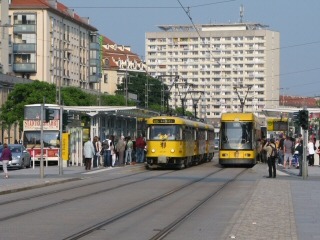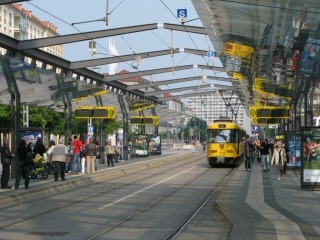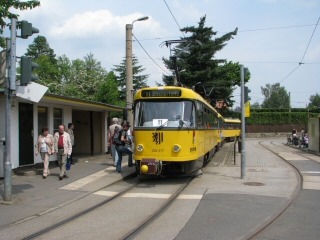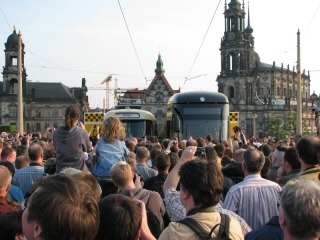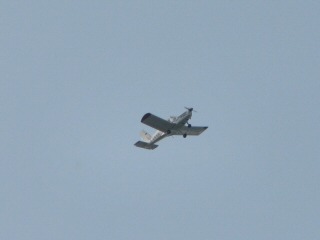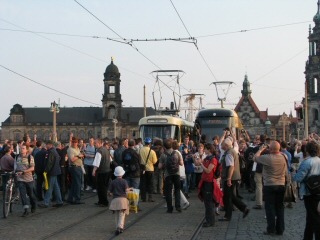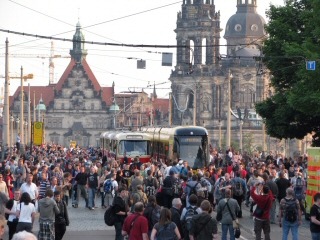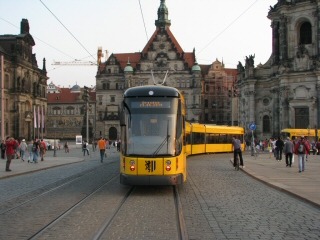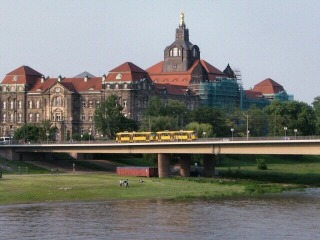Trams of Hungary and much more...
The capital of Saxony has a rather large tramway network, which was constantly modernised since East- and West-Germany was re-united. One of the most visible signs of this was the decreasing numbers of CKD Tatra tramcars in daily operation. May 29, 2010 was selected as the day when the Tatras pass the torch to the new, low-floor vehicles. I say "selected", because it wasn't the last day of Tatras in revenue operation - a batch of them was spared.
The first Tatra in Dresden did its trial runs in 1964. It was a T3, and it soon became clear that it was too wide (2,500 mm), its current consumption was too high and it was also too heavy for the city's tracks. The new, narrower (2,200 mm) type - the T4D - arrived in 1967, with a T1 acting as an unpowered trailer for trial runs. By 1968 the motor car T4D received its unpowered (trailer) counterpart, the B4D. There were many problems with the new vehicles, and soon the Tatras received a nick-name: "Dubcek's revenge". Of course later it got better, and the Tatras have became part of the city landcape.
The museum "Grosszug" (T4D+T4D+B4D)
One of the highlights of May 29th was the triple-set 2000 + 222 998 + 272 105 of the Dresden Tramway Museum.
The usage of Tatra motor + motor + trailer units was characteristic for East-Germany, where high capacity was needed, but the power network was unable to provide enough current for a three-car motor set. Such a formation was called "Grosszug" - "large train" (with motor + trailer being the "Minizug" - "mini train", and motor + motor being called "Traktion"). At start, even some higher notches of the PCC accelerators of motor cars were blocked to prevent high current flow, resulting in other difficulties.
The classic set was always full of tram enthusiasts and "normal people" mixed together.
The triple-set was operating on route 7/E7, which was the first "Tatra line" in Dresden. On these two photos, we see it at Albertplatz.
Photo stop in the Diebsteig reversing loop. To the right: the strange ticket-wending machine of one of the cars.
DVB, Dresden's transit operator also sent its special Tatra-based works vehicles onto the streets. Some of them were not allowed to take passengers, so they were there just to be photographed. Great idea - normally you don't really have a chance to see most of them. Other tram operators should also do this every once in a while.. Or how about an international works car parade? :)
Number 201 009 (to the left) was a depot shunter, while number 201 204 (to the right) was used as a training vehicle. Both featured PCC-type accelerators - in contrast to the last remaining Tatras, which were all modernised with choppers.
To the left: catenary inspection vehicle number 201 122. Unfortunately this car broke down during the day, so I don't have a better photo of it. To the right: rail grinder number 201 002 in front of the Residental Palace.
Dresden only received a small batch of Tatra T6A2D and B6A2D cars, most of which were scrapped, so number 226 001-2 is a pretty unique sight.
To the left: 201 204 again, this time at Albertplatz, with the former traffic operator centre in the background ("Verkehrsbetriebe"). To the right: the busy traffic junction Postplatz is now located about hundred meters away from its original location - originally this small, round, pagoda-like building was its center.
A few short cuts of the works car Tatras.
We've had museum Tatras, we've had special Tatras, now let's see the last "normal" Tatras in operation!
These cars were throughoutly modernised, with chopper instead of accelerator, new doors, etc. A triple-set like the one on the photo on the left (224 269 + 224 235 + 244 034) was not common earlier, AFAIK they're only used in Dresden since the B4D trailers were withdrawn. To the right: 224 218 + 244 047 at Zur neuen Brücke.
A short clip of the yellow Tatras. They were only being used on the "E"-lines - which are peak-hour services on the busiest stretches- during the last months.
To the left: the triple-set 224 267 + 224 266 + 244 066 at the stop Altmarkt. To the right: 224 246 + 224 247 + 244 048 (at least if my records are correct) at Postplatz.
To the right: one of the previously seen triple-sets in Bühlau. To the right: this is not a Tatra, but it was still wort a photo: the special "Dixie train" at the Hofkirche. There was also a "Comedy tram" running up and down in the city that day.
Official celebrations reached their peak when the driver of the museum triple-set passed a torch - or better: a relay-race stick - to the driver of a low-floor tram in front of many people on the Augustusbrücke.
I was unable to see what was passed from Tatra-driver to NGTD12DD-driver because of the crowd... I think the passengers of the small airplane cruising above us (to the right) - a Zlin-42MU, passingly also "made in Czechoslovakia" - have had a better view at what was happening there :)
Taking photos of any usable quality was simply impossible... But the mood was nice, it was good to see so many people at a tramway event!
To the left: the low-floor tram involved in the celebrations left the site running on the "wrong side". To the right: during the celebrations and later the seven "normal" Tatra sets were still doing their rounds in the city. Here we see a double-set on Carolabrücke. But then, it was all over.
As I mentioned, a fair batch of working Tatras was put aside as reserve for future cultural and sport events with a need for extra capacity. These were this day's "normal" trams - and they continued their operation next monday :)


